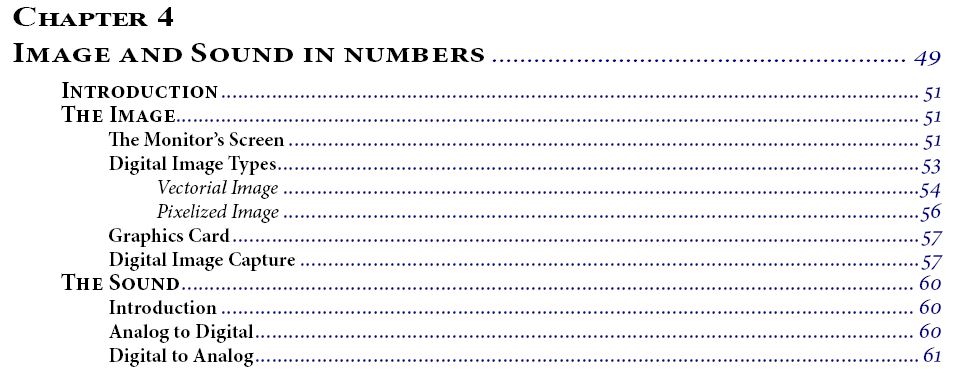Image and Sound in Numbers
We introduce here this Chapter to unwind the description of the logic circuits that will allow us to understand how the bits work in order to achieve the results the computer wants.
The computer is becoming part of citizens everyday ordinary tasks. We went quickly from literacy to computerization. In short, who’s not computerized is illiterate.
Everything is being digitalized in the world we live in today. Images are pretty much all in digital format and those who still have them in analog format seek their conversion. Professional photographers now use digital photography, which reached staggering levels of reliability. Who doesn’t have a digital camera, even if it’s on its cellphone ?
The musics are almost all in digital format. Since the CD arose that it’s happening that way. Most tape recorders use digital format. Therefore, we can say that the sound is almost exclusively in digital format .
TV broadcast is turning off the analog transmissions and introducing the Digital Terrestrial Television. The movies are all available to the common citizen in digital format with the best quality of picture and sound.
The fabulous world of Internet has evolved to amazing people interconnecting levels. Almost everything can be done over the Internet. Purchases, sales, queries, lectures, studies, research, personal bureaucratic issues, tax issues, etc. We rather say that little can be done without the Internet.
The mail between people is slowly evolving to e-mail. The physical archives are being replaced by files in digital format and will always evolve in that sense, even if it is for ecological issues.
The decrease in disk storage value and the increase of its capacity, are accelerating the “numeralization” of our world. Numeralization? What’s that? That’s the digital representation of the visible and audible elements of our world, which as we know is made with numbers in the binary system.
But the image that the computer shows to us in the monitor doesn’t have a numeric shape. It looks as if it’s real for our vision. How can it be made of numbers and have that shape?
This is what we’ll see along this Chapter. How does the computer with zeros and ones, to show us the graphs we work with and through which it communicates with us, our photos, our documents or our work programs.
The picture showed on a screen consists of a set of pixels, the smallest unit of information in an image, containing the definition of one only color. That definition consists in a combination one only one color resulting from the combination of Red, Green and Blue (RGB) in the due proportion and is nowadays normally composed by 32 bits. Each of these pixels is thus represented in the computer by a set of 32 digits 0 and 1. Let’s see how in the course of this chapter.
But the images that surround us are not composed by numbers. The image, as we see it , is composed of a set of waves of various frequencies that define three kinds of colors : Red , Green and Blue, or RGB .
The human eye has two cells responsible for vision, Rods and Cones.
- The cones and main receivers are sensitive to red, green and blue at a wavelength of differentiation that characterizes each of the basic colors. Red is a long wave, Green is a medium wave and Blue is a short wave. The cones are the cells that meet at the center of the retina.
- The rod cells, which are situated on the outskirts of cones are sensitive to green and mainly responsible for peripheral and night vision .
It’s the information sent by these cells to the brain that, after being processed, is converted in the image we see. The colors result from a combination of Red , Green and Blue, according to each one intensity. But this whole process is analog. There’s numbers nowhere. Our view doesn’t see the images in numbers, rather in waves of different frequencies .
Yeah, but the computer understands them in numbers, converts them into numbers , stores them in numbers and puts them on screen or on paper again as sets of numbers which are converted by us in the set of waves that make us see the exact image we captured with our digital camera .
How does our camera receive the waves that make the color we see and convert them in the set of bits that will represent exactly the color that we saw? This is one of the issues that this chapter aims to show .
The same goes for the sound. He is picked up by the ear in the shape of waves coming propagated through the air to us. Then they are worked by the brain to be converted in that wonderful melody that much pleases us or that creepy noise that much we dislike .
How does the computer convert these waves into numbers? And how to convert them back into waves that propagate through the air to our ears? These are other issues that this chapter will show.
See the global synopsis of this work
We introduce here the table of contents of the Paper Book to describe the themes approached in this Chapter

